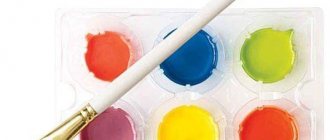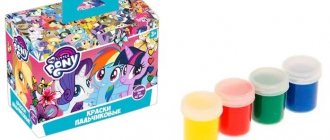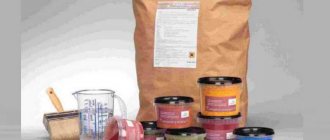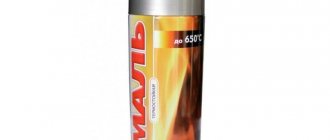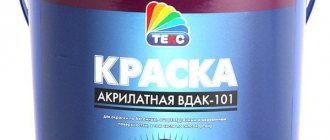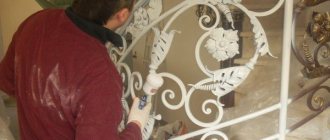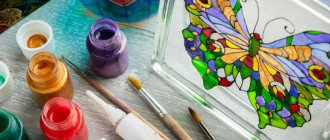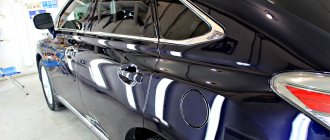To express your creativity through drawing, you need to choose the right materials. Today, a huge number of coloring agents have been created for art, among which painting paints are considered the most common. But they are also different. The types of painting paints and features of use will be discussed in detail below.
Story
They painted even in ancient times; at that time natural dyes were used. People figured out how to use materials of natural origin to create drawings; they used clay, soot, and mineral dyes. Usually they resorted to painting with ocher to get light colors; it was used in its pure form; for a darker tone, charcoal from wood was added.
The later period is characterized in terms of art by the appearance of paints obtained from animal fats. To create different dyes, people tried to mix different elements. About 5,000 years ago, cinnabar was invented, which dyes red. In Egypt they obtained the color purple; the white color for drawings was obtained from lime. The appearance of the watercolor variety is associated with Ancient China. Oil dyes appeared in the Middle Ages.
People figured out how to use natural materials to create drawings.
Canvas sizing
To improve the properties of the canvas, painters often resort to pre-sizing the canvas. This makes it possible to obtain a better basis for creating great works. You can purchase sizing or make it yourself.
To improve the properties of the canvas, painters often resort to pre-sizing the canvas.
Basic properties of sizing
Sizing is used because of several positive properties of this process. To avoid seepage of primer solution and paints through the canvas. Thanks to sizing, the consumption of products is reduced and the strength of the paint coating is improved. It imparts antiseptic properties to the base. Helps extend the life of the coating.
Thanks to sizing, the consumption of products is reduced and the strength of the paint coating is improved.
What are paints needed for and how do they differ?
In ancient times, paints were not used for decorative purposes, and not for admiring masterpieces. The purpose of creating the image was to be able to study the objects. Having drawn an animal, people sought to understand its features and structure. This helped make the hunt easier.
At that time, drawings played a practical role. Later, people began to draw to gain pleasure from contemplation and the process. It is impossible to create a masterpiece of painting without paints, so different types of media were invented for this purpose. There are special artistic paints that have a professional purpose. There are simpler types for a child’s creativity; drawing helps children develop.
If creating drawings is a professional activity, then artists carefully select suitable paints for themselves. The selection criteria are as follows:
- Density of strokes. To create denser layers, oil type and acrylic are used. Watercolor is distinguished by its fine layer structure;
- Resistant to water, if you want to get dense strokes, using water will not give the desired result;
- The brightness of the color, after drying the color may darken, turn pale, and fade. A similar reaction occurs depending on the type of product, as well as the brand;
- Cost, for artists, saving on this material is unacceptable, otherwise it will not be possible to create a masterpiece.
To create denser layers, oil type and acrylic are used.
Gouache
Drawing with this material seems velvety to the touch and appearance, but it can get your hands dirty and smear, but not very much. More often, due to inexperience, artists apply too thick a layer of paint, which is why this area may crumble after drying.
These paints should also be kept away from the sun, and most importantly, the lid should be closed well, otherwise even water will not be able to revive them if you forget them open for a long time.
For those who want to try them as a material, it’s worth learning a couple of tips to get started.
- Gouache loves water, but don't overdo it. Too much water can cause the final work to be sticky and not dry.
- If something doesn't work out for you, don't be discouraged. This paint easily covers the previous layer, which can be used to correct mistakes.
- Any paper can be used. This paint is not as water-based as watercolor, but if you want to preserve your work for a long time, it is better to use a dense material that does not deteriorate longer.
An interesting fact is that Rubens and Picasso also used gouache. Nowadays, many people believe that these are exclusively children's paints, but this is not so. From time immemorial, gouache was used by professionals in their field, even if we remember them as material from childhood.
Kinds
There are different paints for the reason that you can perform different painting techniques with them. For example, there are paints for dot writing. To choose the right tool for a specific job that will help you get a high-quality and beautiful drawing, you should understand the features of the different options. The existing options will be discussed in detail below.
There are different paints for the reason that you can perform different painting techniques with them.
Watercolor
This type is often used when it comes to children's creativity. The name of the species means work using water. The execution of glazing techniques and shade stretches is comfortably done in watercolor; in order to obtain an unusual effect, some skill is required. For a child, this is an opportunity to explore the option of mixing colors and various drawing techniques.
For a child, this is an opportunity to explore the option of mixing colors and various drawing techniques.
Gouache
Gouache can be called a transitional medium between professional and conventional paints. Gouache differs from watercolor material in its better density. But it can be corrected with water, so defects can be easily corrected. Artists sometimes resort to combining watercolor with gouache to achieve an original effect.
Gouache differs from watercolor material in its better density.
Acrylic
Acrylic paints are distinguished by their versatility; they can be applied to glass, fabric, paper, metal and other substrates. The color does not lose its brightness after drying and becomes waterproof. The indelible property allows the painting to be cleaned after drying using water. The dot technique of painting with acrylic paints is popular among professionals. It has a fast drying rate, this must be taken into account when working.
Acrylic paints are distinguished by their versatility; they can be applied to glass, fabric, paper, metal and other substrates.
Oily
This type has been used for a long time; many masterpieces of painting are made with oil paints. They stand out for their durability. Application requires certain skills, they help to draw small details, the long drying time makes it possible to correct defects. It is possible to obtain the desired shade by mixing colors on the canvas itself.
This type has been used for a long time; many masterpieces of painting are made with oil paints.
Tempera
Tempera is the ancestor of gouache and watercolor. It appeared earlier than the oil type; earlier it was popular to make tempera from eggs, water and other components. Using it makes it possible to draw strokes of different thicknesses, it can be diluted with water, and it dries quickly. After drying, there is some change in saturation. But the brightness lasts the longest over the years. After complete drying it becomes indelible. The fast pace of drying requires the painter to obtain the required shade quickly, otherwise the paint in the palette will dry out.
Using it makes it possible to draw strokes of different thicknesses, it can be diluted with water, and it dries quickly.
Neon
The neon type is distinguished by its ability to accumulate light, then in the dark it stands out in strokes and glows beautifully. A similar effect is usually used to decorate interior details and is often used in children's rooms. This is achieved due to the presence of luminescent powder in the composition. Children will really enjoy creating a picture from such a product. Neon paints in cans are convenient for painting surfaces.
The neon type is distinguished by its ability to accumulate light, then in the dark it stands out in strokes and glows beautifully.
Children's paints
For children's creativity, gouache and watercolor paints can be used, as well as special finger paints that mothers of babies love. The latter type provides a good opportunity to develop a child and is safe for health. When choosing a product for children, it is important to choose one without a strong odor and without harmful elements in the composition.
Finger paints provide a good opportunity to develop a child and are safe for health.
With glitter
If you want to add shiny elements to the picture to create a more original work that will be bright. Or to highlight interior details, you can use glitter paints for painting. Sequins can be of different sizes. Glitter paints are an easy way to create a beautiful effect.
Glitter paints are an easy way to create a beautiful effect.
Pastel
Pastel paint for drawing has been known for a long time. It was invented before oil paints; great artists used pastel paints along with oil paints. They are distinguished by their shape, usually a pencil; gum, wax, mineral oils and others can be used as a base. They are applied softly to the surface, they can be retouched and rubbed. Correction is made with an eraser. Pastel paints are best used on paper. Not applicable on smooth substrates.
They are applied softly to the surface, they can be retouched and rubbed.
Contour
Contour paints are made on the basis of acrylic. They differ from the acrylic type by the degree of viscosity. With their help, a 3D effect is created; obtaining a three-dimensional image can be easily achieved with them. Often chosen for decoupage. Universal, can be applied to different surfaces, but there are subtypes for individual materials.
With their help, a 3D effect is created; obtaining a three-dimensional image can be easily achieved with them.
Waterproof
The most popular waterproof paints for creating paintings are acrylics. Color saturation and durability, ease of use, and a wide palette make them an excellent option for artistic ideas.
The most popular waterproof paints for creating paintings are acrylics.
Mother of pearl
Pearlescent paints create an unusual effect on the surface, the layer looks original. If the task is to refresh the picture, then mother-of-pearl will look unconventional. You can find a large number of types of these paints in different colors on the market.
Pearlescent paints create an unusual effect on the surface, the layer looks original.
Oil
Almost everyone knows about oil paints; they are one of the most common materials for painting, but most often they are used only by professionals or advanced amateurs. The oil has several features of its own.
The material takes a long time to dry, this is both good and bad; while drawing you have a lot of time for any changes or additions, but any careless movement can blur the work.
Colors can be applied in several layers and they easily overlap each other, and if necessary they are mixed directly on the canvas. Also, when working with oil, many people use the technique of removing the layer; this can easily be done with a spatula, cloth or palette knife.
It is best to paint with oil on fabric canvases; textiles promote excellent adhesion of this rather harmful paint. This paint takes at least 16 days to dry, but the maximum is only about a month.
A set of standard paints usually has only six colors + white, there are more than a hundred shades of oil, but you can create them yourself, so there is often no point in buying huge sets.
Compound
Depending on the constituent elements contained in the product, its properties will differ, and what base can be used for drawing with them. So there are separate types for paper and canvas.
Depending on the constituent elements contained in the product, its properties will differ.
What types of paints are there for drawing on paper?
The watercolor type is known to everyone; this is where acquaintance with paints usually begins; if you paint with watercolors on the same type of paper, the pictures will be bright, and the base itself will not suffer from exposure to water. Acrylic, finger, tempera, and gouache types can also be used on paper.
The watercolor look is known to everyone; this is where acquaintance with paints usually begins.
What types of paints are there for painting on canvas?
Canvas is a material on which you cannot paint with any paints. Acrylic and oil types are suitable for this purpose. Initially, the plot is drawn with charcoal and pencil, and then the colors are achieved by painting.
Initially, the plot is drawn with charcoal and pencil, and then the colors are achieved by painting.
Tempera
The paint is from ancient times, it was used for centuries even before the creation of oil paints. Tempera first appeared in ancient Egypt and was used for painting sarcophagi. Many icon painters used this material, as well as world famous artists.
Today, the principle of creating these paints has changed a little, but the quality has even improved, despite this, the paint is not so popular compared to others. Varieties of this paint have something in common with others, because it was their ancestor. There are five varieties in total: egg, acrylic, casein-oil, wax-oil and polyvinyl acetate.
Tempera has many benefits. You can use styles and techniques from other paints with it. The paint itself is more resistant not only to moisture, but also to the passage of time, the sun or sudden temperature changes. In terms of drying speed, it is only slightly inferior to acrylic.
Required Tools
The list of necessary tools depends on professionalism. Artists need a palette, brushes of different sizes and from different materials, canvas/paper/cardboard. Oil-based paints require a thinner; it will easily remove them from the skin of your hands and bring them to the desired consistency. An easel and varnish may be required to improve the longevity of the work.
The list of necessary tools depends on professionalism.
Canvas grain
The grain of the canvas can be different, this helps to obtain different designs. The types are suitable for creating various techniques, and are chosen by the artist based on the general idea.
The grain of the canvas can be different, this helps to obtain different designs.
Fine grain canvas
The fabric has a smooth texture. More suitable for painting in thin layers. It is very convenient to write down the smallest elements on such a basis, emphasizing the details.
More suitable for painting in thin layers.
Coarse canvas
Usually chosen to create large sized works. Under mechanical loads, the structure does not change. A suitable option for impasto painting.
Usually chosen to create large sized works.
Scenic canvas
Suitable for oil paints; not used with acrylic and tempera paints due to their ability to allow moisture to pass through. Made from 100% linen fabric. Resistant to stretching and sagging, even when thick layers of dyes are applied.
Made from 100% linen fabric.
Application
Paints can be used to create unusual interiors using patterns, classically for creating paintings. You can also draw with special looks on the face and body, for example, at a party for a theater act, to create makeup. Use is limited only by human imagination.
Paints can be used to create unusual interiors using patterns, classically for creating paintings.
What to look for when choosing a canvas
Recommendations from professionals can help when choosing a canvas for the job. The following tips can be highlighted:
- If the surface is already primed, then it is necessary to check its integrity; there should be no cracks or other defects;
- The degree of tension is important, to make sure that it is sufficient, press the canvas with your finger, returning to its previous state should take no more than a minute;
- The canvas is installed on a flat base, and they look at the distance from the corner to the surface; it should not be higher than 3-5 mm.
The degree of tension is important.
Artists must pay special attention to the choice of paints and canvas. The durability and colors obtained at work depend on their quality. It is easier to perform various painting techniques on special bases, for this reason the choice should be made with knowledge of their specifics.
How to choose
When choosing, you should pay attention to the brand; well-known brands produce high-quality products from good ingredients. Before purchasing, check the condition of the composition; they should not be dry; it is worth checking the expiration date of the product. Harmlessness is important for children's creativity.
When choosing, you should pay attention to the brand; well-known brands produce high-quality products from good ingredients.
Anyone can draw; you can find a variety of creative options on the market. The creator will be able to realize any fantasy if he carefully considers the choice of coloring agent. If you want to do art professionally, you should not skimp on paints.
Canvas size
The size range of canvases is very diverse. Every artist can find a suitable option for themselves without difficulty. When choosing, he is guided by his own preferences. If you don’t know in advance what kind of painting it will be, then you can purchase a rolled version and cut it to the required size when you come to inspiration.
The size range of canvases is very diverse.
Acrylic brushes
It is important to have a good selection of brushes, from small to large.
Acrylic brushes are usually made from synthetic materials. Do not use oil or watercolor brushes.
These four brushes are some of the most common shapes you'll come across:
Acrylic brushes tend to be longer and stronger
than watercolor brushes, and this is really necessary as they press harder into the work surface while painting.

